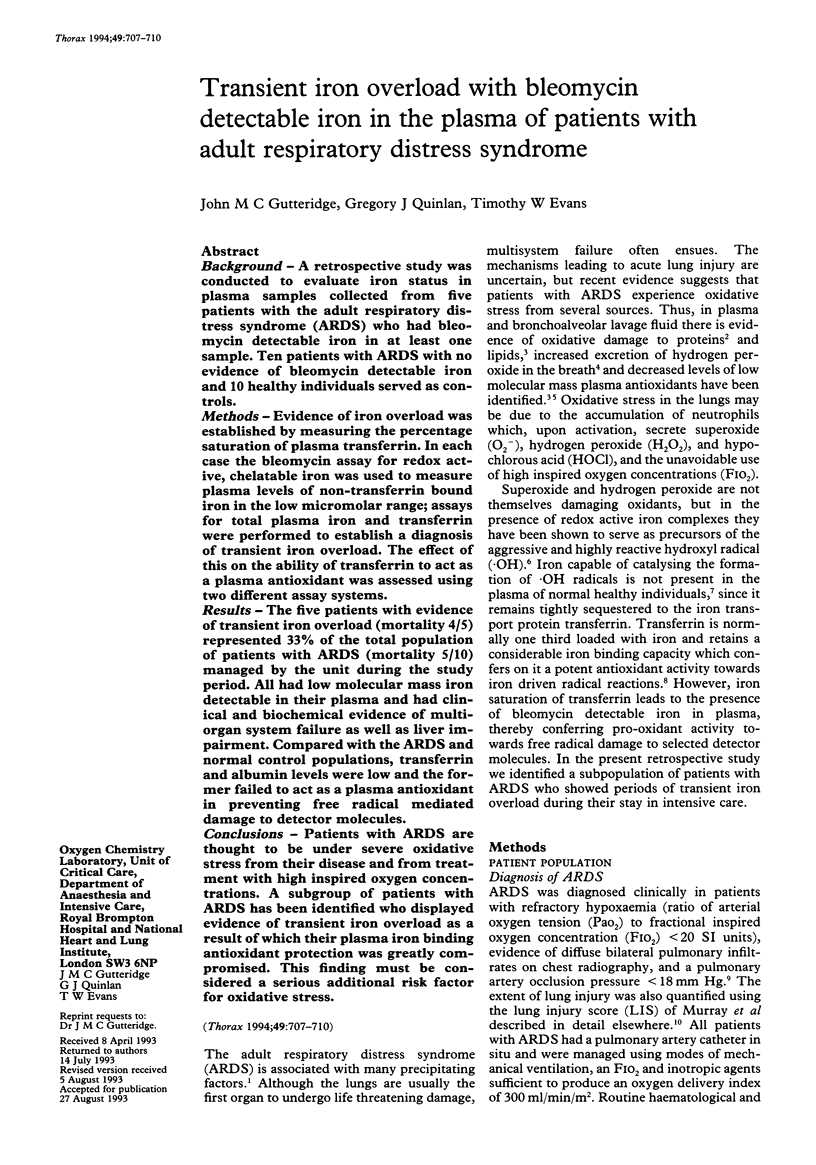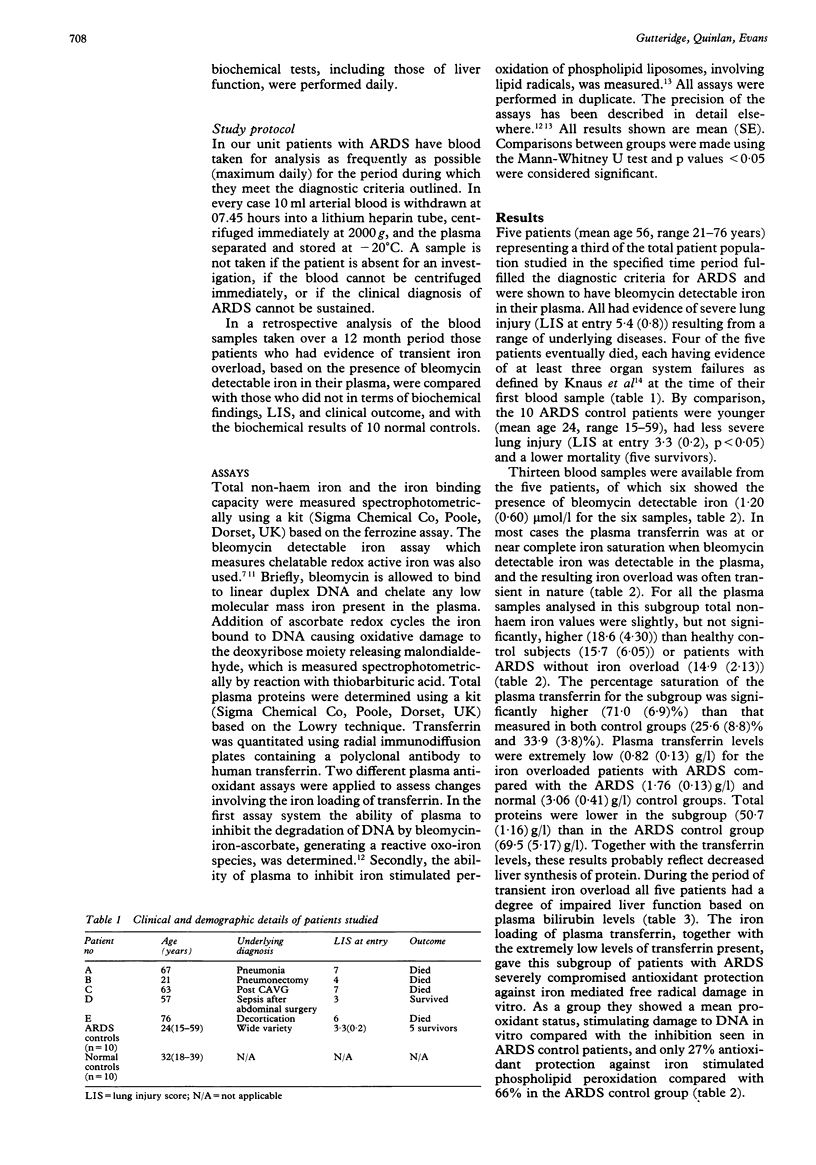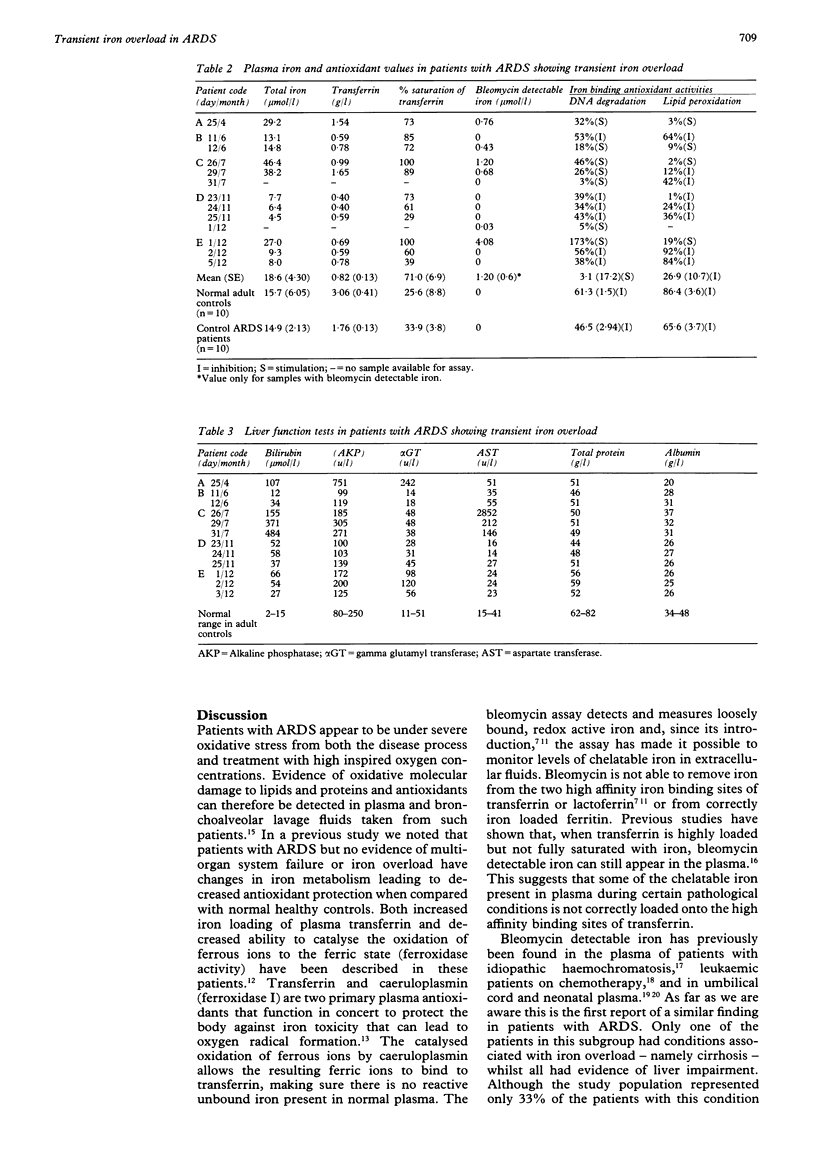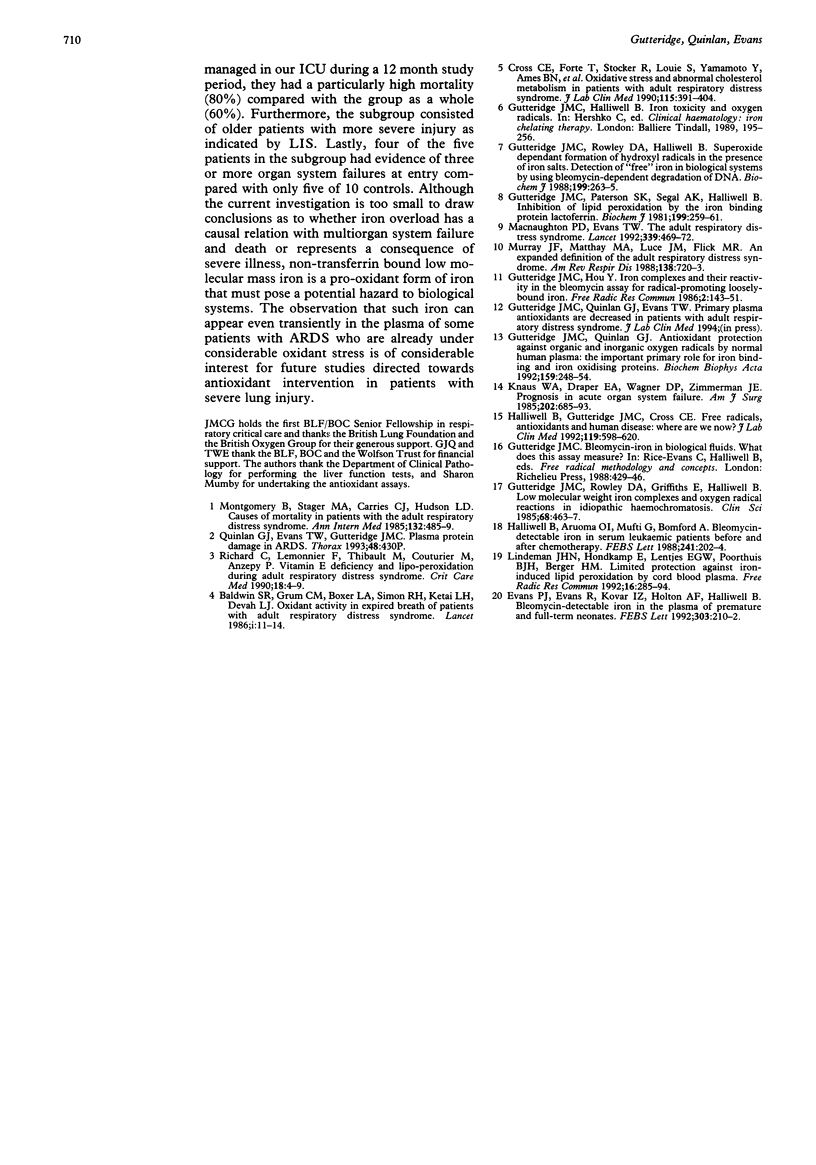Abstract
BACKGROUND--A retrospective study was conducted to evaluate iron status in plasma samples collected from five patients with the adult respiratory distress syndrome (ARDS) who had bleomycin detectable iron in at least one sample. Ten patients with ARDS with no evidence of bleomycin detectable iron and 10 healthy individuals served as controls. METHODS--Evidence of iron overload was established by measuring the percentage saturation of plasma transferrin. In each case the bleomycin assay for redox active, chelatable iron was used to measure plasma levels of non-transferrin bound iron in the low micromolar range; assays for total plasma iron and transferrin were performed to establish a diagnosis of transient iron overload. The effect of this on the ability of transferrin to act as a plasma antioxidant was assessed using two different assay systems. RESULTS--The five patients with evidence of transient iron overload (mortality 4/5) represented 33% of the total population of patients with ARDS (mortality 5/10) managed by the unit during the study period. All had low molecular mass iron detectable in their plasma and had clinical and biochemical evidence of multiorgan system failure as well as liver impairment. Compared with the ARDS and normal control populations, transferrin and albumin levels were low and the former failed to act as a plasma antioxidant in preventing free radical mediated damage to detector molecules. CONCLUSIONS--Patients with ARDS are thought to be under severe oxidative stress from their disease and from treatment with high inspired oxygen concentrations. A subgroup of patients with ARDS has been identified who displayed evidence of transient iron overload as a result of which their plasma iron binding antioxidant protection was greatly compromised. This finding must be considered a serious additional risk factor for oxidative stress.
Full text
PDF



Selected References
These references are in PubMed. This may not be the complete list of references from this article.
- Baldwin S. R., Simon R. H., Grum C. M., Ketai L. H., Boxer L. A., Devall L. J. Oxidant activity in expired breath of patients with adult respiratory distress syndrome. Lancet. 1986 Jan 4;1(8471):11–14. doi: 10.1016/s0140-6736(86)91895-7. [DOI] [PubMed] [Google Scholar]
- Cross C. E., Forte T., Stocker R., Louie S., Yamamoto Y., Ames B. N., Frei B. Oxidative stress and abnormal cholesterol metabolism in patients with adult respiratory distress syndrome. J Lab Clin Med. 1990 Apr;115(4):396–404. [PubMed] [Google Scholar]
- Evans P. J., Evans R., Kovar I. Z., Holton A. F., Halliwell B. Bleomycin-detectable iron in the plasma of premature and full-term neonates. FEBS Lett. 1992 Jun 1;303(2-3):210–212. doi: 10.1016/0014-5793(92)80521-h. [DOI] [PubMed] [Google Scholar]
- Gutteridge J. M., Hou Y. Y. Iron complexes and their reactivity in the bleomycin assay for radical-promoting loosely-bound iron. Free Radic Res Commun. 1986;2(3):143–151. doi: 10.3109/10715768609088066. [DOI] [PubMed] [Google Scholar]
- Gutteridge J. M., Paterson S. K., Segal A. W., Halliwell B. Inhibition of lipid peroxidation by the iron-binding protein lactoferrin. Biochem J. 1981 Oct 1;199(1):259–261. doi: 10.1042/bj1990259. [DOI] [PMC free article] [PubMed] [Google Scholar]
- Gutteridge J. M., Quinlan G. J. Antioxidant protection against organic and inorganic oxygen radicals by normal human plasma: the important primary role for iron-binding and iron-oxidising proteins. Biochim Biophys Acta. 1992 Oct 20;1159(3):248–254. doi: 10.1016/0167-4838(92)90052-f. [DOI] [PubMed] [Google Scholar]
- Gutteridge J. M., Rowley D. A., Griffiths E., Halliwell B. Low-molecular-weight iron complexes and oxygen radical reactions in idiopathic haemochromatosis. Clin Sci (Lond) 1985 Apr;68(4):463–467. doi: 10.1042/cs0680463. [DOI] [PubMed] [Google Scholar]
- Gutteridge J. M., Rowley D. A., Halliwell B. Superoxide-dependent formation of hydroxyl radicals in the presence of iron salts. Detection of 'free' iron in biological systems by using bleomycin-dependent degradation of DNA. Biochem J. 1981 Oct 1;199(1):263–265. doi: 10.1042/bj1990263. [DOI] [PMC free article] [PubMed] [Google Scholar]
- Halliwell B., Aruoma O. I., Mufti G., Bomford A. Bleomycin-detectable iron in serum from leukaemic patients before and after chemotherapy. Therapeutic implications for treatment with oxidant-generating drugs. FEBS Lett. 1988 Dec 5;241(1-2):202–204. doi: 10.1016/0014-5793(88)81061-5. [DOI] [PubMed] [Google Scholar]
- Halliwell B., Gutteridge J. M., Cross C. E. Free radicals, antioxidants, and human disease: where are we now? J Lab Clin Med. 1992 Jun;119(6):598–620. [PubMed] [Google Scholar]
- Knaus W. A., Draper E. A., Wagner D. P., Zimmerman J. E. Prognosis in acute organ-system failure. Ann Surg. 1985 Dec;202(6):685–693. doi: 10.1097/00000658-198512000-00004. [DOI] [PMC free article] [PubMed] [Google Scholar]
- Lindeman J. H., Houdkamp E., Lentjes E. G., Poorthuis B. J., Berger H. M. Limited protection against iron-induced lipid peroxidation by cord blood plasma. Free Radic Res Commun. 1992;16(5):285–294. doi: 10.3109/10715769209049181. [DOI] [PubMed] [Google Scholar]
- Macnaughton P. D., Evans T. W. Management of adult respiratory distress syndrome. Lancet. 1992 Feb 22;339(8791):469–472. doi: 10.1016/0140-6736(92)91068-j. [DOI] [PubMed] [Google Scholar]
- Montgomery A. B., Stager M. A., Carrico C. J., Hudson L. D. Causes of mortality in patients with the adult respiratory distress syndrome. Am Rev Respir Dis. 1985 Sep;132(3):485–489. doi: 10.1164/arrd.1985.132.3.485. [DOI] [PubMed] [Google Scholar]
- Murray J. F., Matthay M. A., Luce J. M., Flick M. R. An expanded definition of the adult respiratory distress syndrome. Am Rev Respir Dis. 1988 Sep;138(3):720–723. doi: 10.1164/ajrccm/138.3.720. [DOI] [PubMed] [Google Scholar]
- Richard C., Lemonnier F., Thibault M., Couturier M., Auzepy P. Vitamin E deficiency and lipoperoxidation during adult respiratory distress syndrome. Crit Care Med. 1990 Jan;18(1):4–9. doi: 10.1097/00003246-199001000-00002. [DOI] [PubMed] [Google Scholar]


